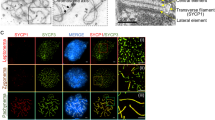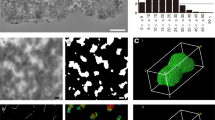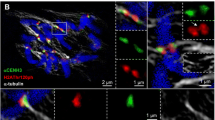Abstract
This study reports the persistence of axis-like structures in the centromeric region of both homologues during the metaphase-I and anaphase-I stages of meiotic division of mouse spermatocytes. A novel type of silver ‘argentaffin’ technique (NH4−Ag) is employed. This technique includes the treatment of glutaraldehyde-fixed tissues with dilute ammonium hydroxide followed by a reduction of aldehyde groups with sodium borohydride. Staining is accomplished with ammoniacal silver nitrate in darkness followed by sulfite washing. The lateral elements of synaptonemal complexes and the single chromosomal axes of diplotene spermatocytes show a prominent reactivity with this technique. The pattern of very small grains over condensed chromatin is uniform and gives only a light opacity to the electron beam. The presence of an axis-like structure is seen in every centromeric end of meiotic chromosomes at metaphase I and anaphase I. The chromatin (heterochromatin) that surrounds the centromeric filament and some material distributed in irregular linear arrays along some of the homologues also showed a higher electron opacity than the bulk of deoxyribonucleoprotein. While the former is related to C+ heterochromatin, the latter could represent dispersed material of diplotene axes. It is suggested that the disposal of axial material is differentially delayed at the centromeric regions. The present evidence supports the hypothesis that axial fragments or lateral-element segments persisting at these regions contribute to the cohesiveness of centromeres of sister chromatids during normal disjunction.
Similar content being viewed by others
References
Dresser, M. E. & Moses, M. J., 1980. Synaptonemal complex karyotyping in spermatocytes of the Chinese hamster (Cricetulus griseus). IV. Light and electron microscopy of synapsis and nucleolar development by silver staining. Chromosoma 76: 1–22.
Earnshaw, W. C. & Laemmli, U. K., 1984. Silver staining of the chromosome scaffold. Chromosoma 89: 186–192.
Gallyas, F., 1982. Physico-chemical mechanism of the argyrophil I reaction. Histochemistry 74: 393–407.
Gautier, H., 1976. Ultrastructural localization of DNA in ultrathin tissue sections. Int. Rev. Cytol. 44: 114–191.
Heyting, C., Dettmers, R. J., Dietrich, A. J. J., Redecker, J. W. & Vink, A. C. G., 1988. Two major components of synaptonemal complexes are specific for meiotic prophase nuclei. Chromosoma 96: 325–332.
Howell, W. M., 1982. Selective staining of nucleolus organizing regions (NORs), vol XI, pp. 89–141. In: The Cell Nucleus, edited by H.Busch and L.Rothblum. Academic Press Inc., New York.
Jimenez-Garcia, L. F., Rothblum, L. I., Busch, H. & Ochs, R. L., 1989. Nucleologenesis: use of non-isotopic in situ hybridization and immunocytochemistry to compare the localization of rDNA and nucleolar proteins during mitosis. Biol. Cell 65: 239–246.
Knibiehler, B., Mirre, C., Hartung, M., Jean, P. & Stahl, A. 1981. Sex-vesicle-associated nucleolar organizers in mouse spermatocytes: localization, structure sand function. Cytogenet. Cell Genet. 31: 47–57.
Lillie, R. D. & Pizzolato, P., 1972. Histochemical use of borohydrides as aldehyde blocking agents. Stain Technol. 47: 13–17.
Luykx, P., 1974. The organization of meiotic chromosomes pp. 163–207. In: The Cell Nucleus, edited by H.Busch, Vol. II. Academic Press, New York.
Maguire, M. P., 1974. The need for a chiasma binder. J. theor. Biol. 48: 485–487.
Maguire, M. P., 1978. A possible role for the synaptonemal complex in chiasma maintenance. Exptl. Cell Res. 112: 297–308.
Moens, P. B., 1969. Multiple core complexes in grasshopper spermatocytes and spermatids. J. Cell Biol. 40: 542–551.
Moens, P. B. & Church, K., 1979. The distribution of synaptonemal complex material in metaphase I bivalents of Locusta and Chlolealtis. (Orthoptera:Acrididae). Chromosoma 73: 247–254.
Moses, M. J., 1977. The synaptonemal complex and meiosis, pp. 101–125. In: Molecular Human Cytogenetics, edited by R. S.Sparkes, D. E.Comings and D. F.Fox, Academic Press, New York.
Moses, M. J., Dresser, M. E. & Poorman, P., 1984. Composition and role of the SC, pp. 245–270. In: Controlling events in meiosis, edited by C. W.Evans and H. G.Dickerson, Vol. 3. The Company of Biologists, Cambridge, U.K.
Nicklas, R. B., 1961. Recurrent pole to pole movements of the sex chromosome during prometaphase-I in Melanoplus differentialis spermatocytes. Chromosoma 12: 97–115.
Nicklas, R. B., 1988. Chromosomes and kinetochores do more in mitosis than previously thought, in Chromosome Structure and Function, edited by J. P.Gustafson and R.Appels, pp. 53–74, Plenum Publishing Corp., New York.
Ochs, R. L., Lischwe, M. A., Shen, E., Carrol, R. E. & Busch, H., 1985. Nucleologenesis: composition and fate of prenucleolar bodies. Chromosoma 92: 330–336.
Rieder, C. L., 1982. The formation, structure and composition of the mammalian kinetochore and kinetochore fiber. Int. Rev. Cytol. 79: 1–58.
Risueno, M. C., Testillano, P. S., Ollacarizqueta, M. A. & Tandler, C. J., 1990. The ‘argentaffin’ reaction of the nucleolus. Silver reducing sites after mercuric acetate and copper tetrammine treatments, in Nuclear Structure and Function, edited by J. R.Harris, and I. B.Zbarsky. Plenum Press, New York, in the press.
Rufas, J. S., Gimenez-Martin, G. & Esponda, P., 1982. Presence of a chromatid core in mitotic and meiotic chromosomes of grasshoppers. Cell Biol. Int. Reports 6: 261–267.
Rufas, J. S., Gimenez-Abian, J., Suja, J. A., and Garcia de la Vega, C., 1987. Chromosome organization in meiosis revealed by light microscope analysis of silver-stained cores. Genome 29: 706–712.
Sheridan, W. F. & Barrnett, R. J., 1969. Cytochemical studies on chromosome ultrastructure. J. Ultrastruct. Res. 27: 216–229.
Solari, A. J., 1969. The evolution of the ultrastructure of the sex chromosomes (sex vesicle) during meiotic prophase in mouse spermatocytes. J. Ultrastruct. Res. 27: 67–75.
Solari, A. J., 1970. The behavior of chromosomal axes during diplotene in mouse spermatocytes. Chromosoma 31: 217–230.
Solari, A. J., 1974. The relationship between chromosomes and axes in the chiasmatic XY pair of the Armenian hamster (Cricetulus migratorius). Chromosoma 48: 89–106.
Solari, A. J., 1979. Autosomal synaptonemal complexes and sex chromosomes without axes in Triatoma infestans (Reduviidae; Hemiptera). Chromosoma 81: 315–337.
Solari, A. J., 1981. Chromosomal axes during and after diplotene, pp. 178–186, in International Cell Biology 1980–1981, edited by H. G.Schweiger. Springer-Verlag, Berlin.
Solari, A. J. & Ashley, T., 1977. Ultrastructure and behavior of the achiasmatic, telosynaptic XY pair of the sand rat (Psammomys obesus). Chromosoma 62: 319–336.
Solari, A. J. & Counce, S. J., 1977. Synaptonemal complex karyotyping in Melanoplus differentialis. J. Cell Sci. 26: 229–250.
Tandler, C. J., 1959. The silver-reducing property of the nucleolus and the formation of prenucleolar material during mitosis. Exptl. Cell Res. 17: 560–564.
Tandler, C. J. & Pellegrino de Iraldi, A., 1989. A silver-reducing component in rat striated muscle. I. Selective localization at the level of the terminal-cistern/transverse tubule system. Histochemistry 92: 15–22.
Tandler, C. J., Gonzalez, D. A., Remorini, P. G. & Pellegrino de Iraldi, A., 1989. A silver-reducing component in rat striated muscle. II. Isolated sarcoplasmic reticulum. Histochemistry 92: 23–27.
Tandler, C. J. & Pellegrino de Iraldi, A., 1990. Staining terminal cisternae proteins in rat skeletal muscle triads: selectivity of a new silver technique, in Electron Microscopy 1990, edited by L. D.Peachey and D. B.Williams. San Francisco Press Inc., San Francisco, vol. 3: 736–737.
Wettstein, D. v., Rasmussen, S. W. & Holm, P. B., 1984. The synaptonemal complex in genetic segregation. Ann. Rev. Genet. 18: 331–413.
Westergaard, M. & vonWettstein, D., 1970. Studies on the mechanism of crossing-over. IV. The molecular organization of the synaptinemal complex in Neotiella (Cooke) Saccardo (Ascomycetes). C. R. Trav. Lab. Carlsberg 37: 239–268.
Author information
Authors and Affiliations
Rights and permissions
About this article
Cite this article
Tandler, C.J., Solari, A.J. An ‘axis-like’ material in the centromeric region of metaphase-I chromosomes from mouse spermatocytes. Genetica 84, 39–49 (1991). https://doi.org/10.1007/BF00123983
Received:
Accepted:
Issue Date:
DOI: https://doi.org/10.1007/BF00123983




